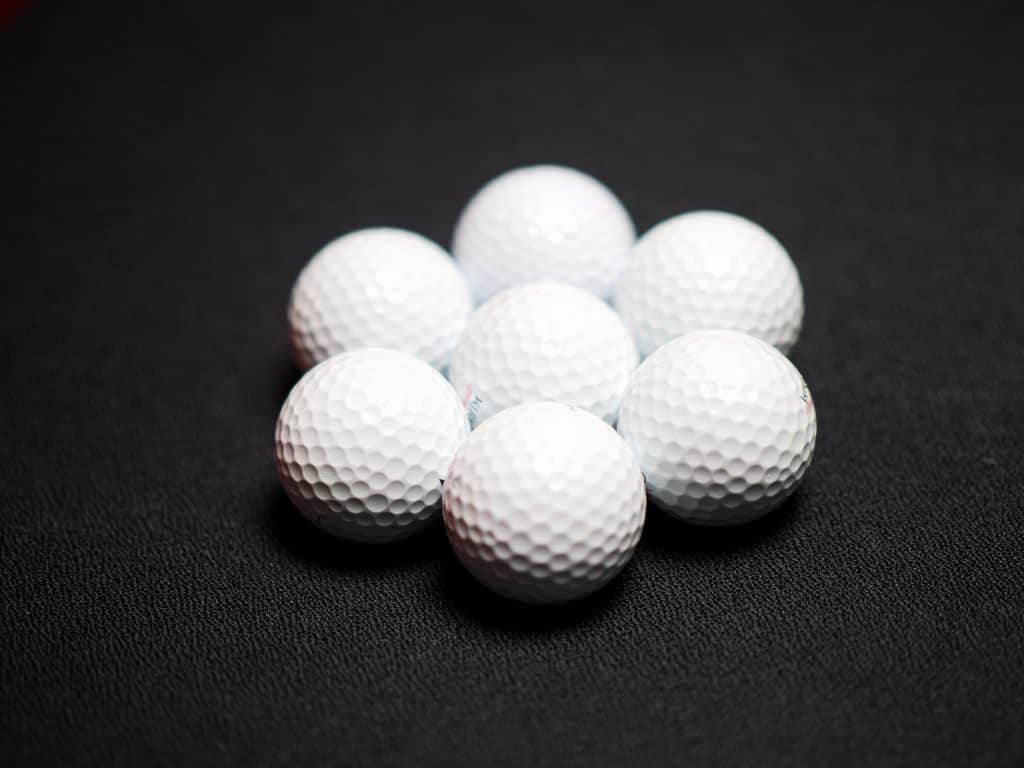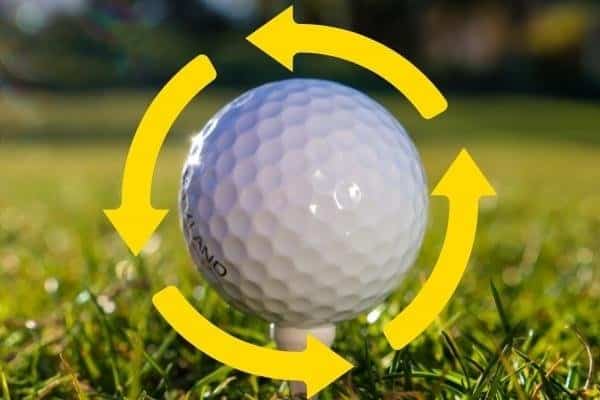The golf ball is one of the most unique pieces of sporting equipment in the world, with its trademark ‘dimples’ making it instantly recognisable by almost everyone – even people who don’t play the sport.
These hundreds of small valleys or indentations that cover the surface of the golf ball give it a distinguishable look, but their purpose is much more than simply superficial.
So, why is it that golf balls have dimples? What are they actually for?
Golf balls have dimples to reduce wind resistance, or aerodynamic ‘drag’. When you reduce this drag, you can make golf balls travel a lot farther through the air. Hence, dimples are a crucial component to maximising a golf ball’s distance.
There is some simple science behind why dimples increase flight time, which I’m going to unpack more in this article – along with explaining some of the history behind this interesting design concept.
If you’re just starting out in the game of golf, you might also like to read our review of the Best Golf Balls For Beginners and High Handicappers here.
Table of contents
How do dimples increase a golf ball’s distance?
Dimples help tighten airflow around the golf ball by creating pockets of turbulence all over its surface, reducing how much ‘detached air’ trails behind the ball. A more attached airflow creates a smaller wake – or low-pressure zone – behind the golf ball, decreasing drag and increasing distance.
Now, while I did complete Year 12 physics at school, I don’t claim to be an expert in aerodynamics – which is why I’ve done my online research and found someone who is more qualified to speak on this topic.
One of the best explanations for how dimples affect a golf ball comes from USGA Equipment Standards Specialist Steve Quintavalla, who sums up the science perfectly in detail below.
He says:
As the golf ball is airborne, the wind is meeting the surface and pushing against it, and then wrapping around it.
If the golf ball were smooth, the air flowing closest to the surface of the ball would follow the flow of air around it, creating a detached airflow behind the ball.
The air that’s closest to the surface doesn’t want to stick to it; it wants to stick to the fast-moving flow.
The detached flow causes a wake to form behind the ball, which creates a low-pressure zone that causes drag – it’s almost like a vacuum that’s sucking the ball back and slowing it down in the face of the wind.
Adding dimples to the ball changes how the air flows over it – as air travels over one of the dimples, a tiny pocket of turbulence (or ‘air disturbance’) is created on the surface.
Instead of impeding the flight of the ball, these tiny pockets of turbulence allow the closer layer of air to travel tighter around it.
A more attached airflow creates a smaller wake and thus a smaller low-pressure zone, which means less drag.
You can watch the full video explaining the process below:
So, there you have it – dimples create small pockets of turbulence, allowing the air to travel closer around the surface of the golf ball, reducing drag and increasing distance.
But you’re probably asking: how did golf manufacturers figure this out? Well, there’s an interesting story behind that, too.
When did golf balls first have dimples?
Back in the late 1800s, golfers who used smooth balls soon discovered the longer they used them, the more distance they could get. This was because over time, the scuff marks created on the ball allowed airflow to attach itself closer to the surface, reducing drag. By 1905, an English manufacturer named William Taylor had registered a patent for a golf ball dimple design.
What began as a side effect of using smooth golf balls for extended periods of time unintentionally paved the way for how they look today. Remarkable.
Nowadays, while golf balls come in different colors and are made out of varying materials (depending on their quality), all of them have dimples.
So, then, how did golf balls perform way back in the day when they were smooth? Now that you know the physics behind it, the answer is easy.
What happens when you remove dimples from a golf ball?
Removing dimples from a golf ball will reduce how far it travels through the air. Without dimples, airflow around the surface of the golf ball becomes more detached, creating a larger low-pressure zone (or ‘wake’) behind it. This, in turn, increases drag and decreases flight time.
In fact, a golf ball with dimples will travel almost twice as far than one without them – demonstrating just how important these small indents are when it comes to performance.
This, however, raises another interesting question: does it make more sense, then, to cram as many dimples as possible onto a golf ball in order to maximise distance? The answer: not necessarily.
Is it better to have more dimples on a golf ball?
In order to fit more dimples onto a golf ball, they need to be made smaller which can cause greater detachment of the airflow around its surface and increase drag (negatively impacting distance). Manufacturers do significant testing to determine the optimal number of dimples that will produce ideal lift and carry distance.
While the USGA does not regulate golf ball dimples, most are around 0.010 inches deep – although they can vary in shape and numbers depending on each brand.
Each golf ball will be designed slightly differently by each manufacturer to try and outperform their competitors, which is why a Titleist Pro V1x feels slightly different off the clubface and has subtle differences in appearance to a Bridgestone BXS, for example.

How many dimples does a golf ball have?
A golf ball typically has between 300-500 dimples, although this will vary depending on the manufacturer. American-made golf balls usually have 336 dimples as the standard number, while British-made golf balls tend to have 330. The size and shape of the dimples can also differ.
Of course, these are only estimates and you’re unlikely to notice the difference in performance between a golf ball that has 300-350 dimples compared to 350-400 dimples.
More important is the feel of the ball off the clubface (whether you like it softer or harder); the distance it generates off the tee; and how receptive it is around the greens.
These factors will influence a golfer’s purchase decision far more than the number of dimples a ball has.
What golf ball has the most dimples?
The Mizuno RB566 and Mizuno RB566V have the most dimples among legal golf balls with 556 (made possible by a micro dimple design). The Volvik Pro Bismuth comes in second with 446 dimples; the Slazenger Raw Distance has 428; while the Maxfli U/2, U/3 and U/6 golf balls come in equal fourth with 422 dimples.
Golf Info Guide have put together a fantastic, detailed table that lists the dimple numbers of the most common golf balls on the market, which you can check out here.
Final message
Golf ball dimples work to increase distance and also lift, maximising how long the ball stays in the air.
Without dimples, golf balls would travel around half as far as what they do today.
While they may vary slightly in size and number, all golf balls in the modern era incorporate the use of dimples into their design, improving performance for all players – from the weekend warrior, right up to the tour pro.


